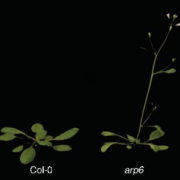New paper connecting GA signaling and ambient-temperature mediated flowering
Gibberellic acid signaling is required for ambient temperature-mediated induction of flowering in Arabidopsis thaliana
Galvão, V. C., Collani, S, Horrer, D., Schmid, M.
Distinct molecular mechanisms integrate changes in ambient temperature into the genetic pathways that govern flowering time in Arabidopsis thaliana. Temperature-dependent eviction of the histone variant H2A.Z from nucleosomes has been suggested to facilitate the expression of FT by PIF4 at elevated ambient temperatures. Here we show that, in addition to PIF4, PIF3 and PIF5, but not PIF1 and PIF6, can promote flowering when expressed specifically in phloem companion cells (PCC), where they can induce FT and its close paralog, TSF. However, despite their strong potential to promote flowering, genetic analyses suggest that the PIF genes seem to have only a minor role in adjusting flowering in response to photoperiod or high ambient temperature. In addition, loss of PIF function only partially suppressed the early flowering phenotype and FT expression of the arp6 mutant, which is defective in H2A.Z deposition. In contrast, the chemical inhibition of gibberellic acid (GA) biosynthesis resulted in a strong attenuation of early flowering and FT expression in arp6. Furthermore, GA was able to induce flowering at low temperature (15 degrees C) independently of FT, TSF, and the PIF genes, probably directly at the shoot apical meristem. Together, our results suggest that the timing of the floral transition in response to ambient temperature is more complex than previously thought and that GA signaling might play a crucial role in this process. This article is protected by copyright. All rights reserved.


